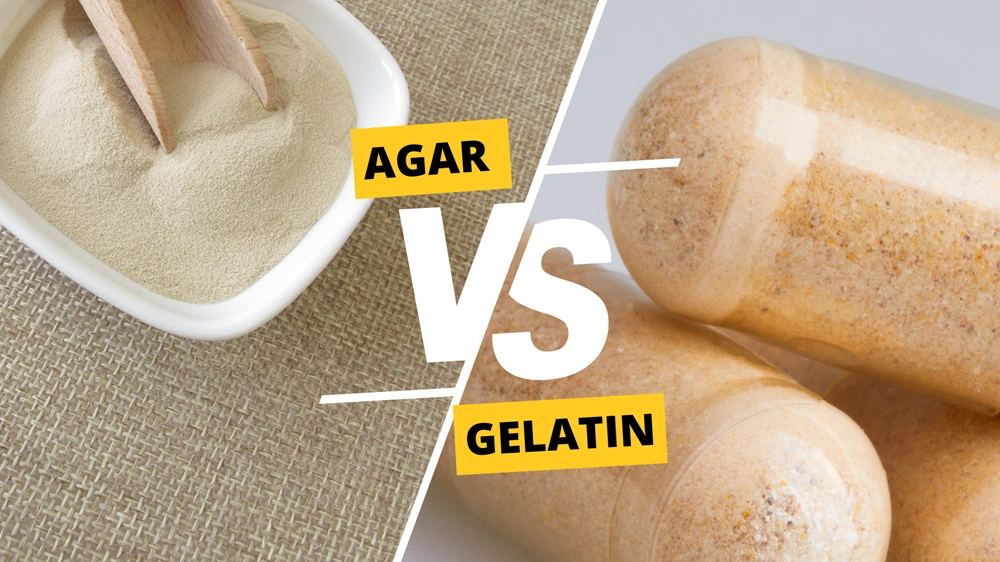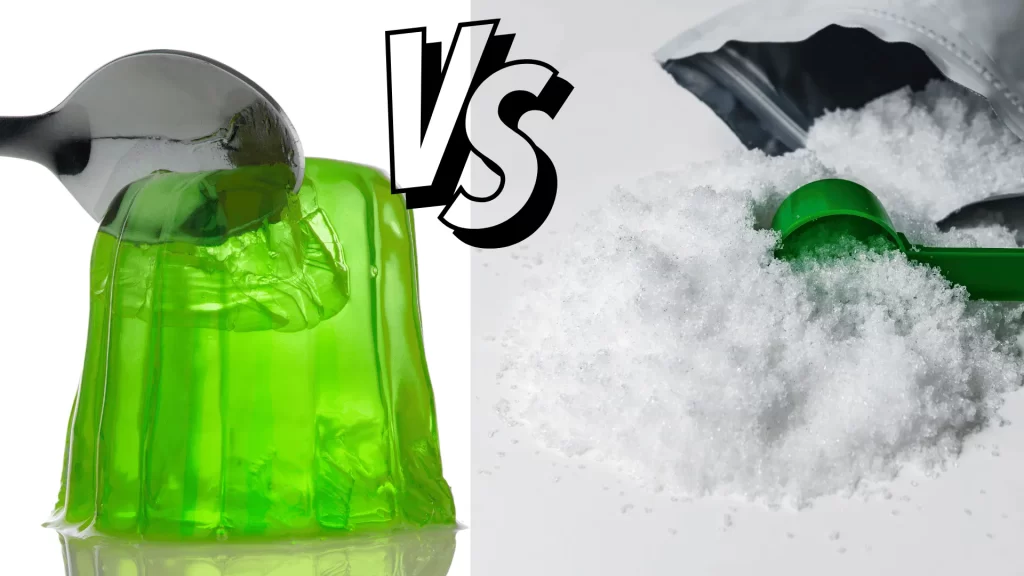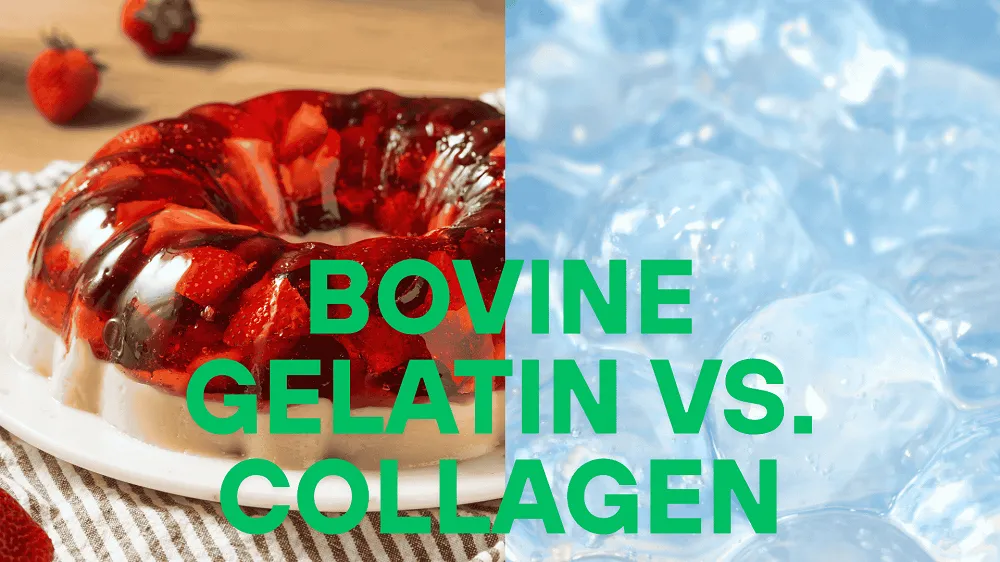Agar Agar vs Gelatin:Picture yourself in the kitchen, ready to create a dessert that’s both delicious and visually stunning. You’ve got your ingredients lined up, but the recipe calls for a gelling agent, and you’re torn between two options: agar agar or gelatin? It’s like choosing between a trusty old friend and a new, eco-conscious pal. Both can transform your liquid concoctions into wobbly wonders, but they come from different worlds and bring unique vibes to your dishes. As a home cook or a food enthusiast, understanding the differences between agar agar and gelatin can make or break your culinary masterpiece. Let’s dive into this gelatinous journey, exploring what these ingredients are, their benefits, whether they can swap places, and how to pick the perfect one for your needs. Trust me, by the end, you’ll be ready to whip up jellies, panna cottas, or even sports nutrition supplements with confidence!
What is Agar Agar?

Agar agar, often just called agar, is like the unsung hero of the vegan kitchen. It’s a jelly-like substance extracted from red algae, specifically species like Gelidium and Gracilaria, found in the ocean’s depths. Imagine it as nature’s answer to creating firm, sliceable gels without a hint of animal products. Chemically, agar is a mix of polysaccharides—mostly agarose, with a dash of agaropectin—giving it its superpower to set liquids into a solid form .
You’ll find agar in various forms: powder, flakes, bars, or even strands. The powder, often produced through precise powder manufacturing processes, is the go-to for most home cooks because it dissolves quickly and is easy to measure. In Asian cuisine, agar shines in desserts like Japanese anmitsu or colorful Southeast Asian jellies, but its talents extend beyond the kitchen. Ever heard of those petri dishes in science labs? Yep, agar’s the star there too, providing a solid base for growing bacteria and fungi. It’s also used in dietary supplement ingredients for its gelling properties and nutritional perks. Talk about a multi-tasker!
What is Gelatin?

Now, let’s meet gelatin, the classic gelling agent that’s been jiggling its way into our hearts for centuries. Gelatin is a protein derived from collagen, which is extracted by boiling animal skin, bones, and connective tissues—usually from cows or pigs . It’s like the culinary equivalent of turning leftovers into gold. The process breaks down collagen into smaller peptides, creating a colorless, flavorless substance that transforms into a wobbly gel when cooled.
Gelatin comes in powder or sheet form, with the powder being a favorite for its ease of use in recipes. It’s the magic behind childhood favorites like jellies, marshmallows, and creamy panna cotta. Beyond desserts, gelatin is a staple in pharmaceuticals (think vitamin capsules) and cosmetics, thanks to its ability to form smooth, flexible gels. In sports nutrition, gelatin is often included in products aimed at supporting joint health, making it a versatile ingredient in both food and wellness.
Benefits of Agar Agar
Agar agar isn’t just a vegan lifesaver; it’s packed with health benefits that make it a standout choice. Its high fiber content—about 80% by weight—makes it a darling for those watching their waistlines. When consumed, agar forms a gel in your stomach, helping you feel full and potentially reducing calorie intake, which is why it’s a key player in Japan’s “kanten diet” for weight loss . A 2019 study found that agar from Gelidium amansii helped reduce body weight and cholesterol levels in animal models, though human studies are still catching up .
Beyond weight management, agar’s fiber promotes healthy digestion by acting as a natural laxative, easing constipation and supporting gut health . It’s also rich in minerals like calcium, iron, and magnesium, which are essential for strong bones, oxygen transport, and muscle function. Some early research suggests agar may help regulate blood sugar by slowing glucose absorption, which could be a boon for managing diabetes, but more studies are needed to confirm this . For those creating dietary supplement ingredients, agar’s nutritional profile and gelling ability make it a top choice for vegan-friendly capsules and tablets.
Benefits of Gelatin
Gelatin, on the other hand, brings its own set of benefits to the table, largely due to its high protein content—nearly 99% protein by weight . It’s rich in amino acids like glycine and proline, which are building blocks for collagen, the protein that keeps your joints, bones, and skin in tip-top shape. A 2017 study suggested that gelatin supplements could reduce joint pain and improve function in people with osteoarthritis, making it a favorite in sports nutrition for athletes looking to support recovery .
Gelatin also shines for skin health. Its collagen-derived amino acids may improve skin elasticity and hydration, potentially keeping those wrinkles at bay . For your gut, gelatin might help repair the intestinal lining, which could be a game-changer for conditions like leaky gut syndrome, though human studies are still limited . Some folks even claim gelatin helps with weight loss by promoting satiety, similar to agar, but the evidence here is more anecdotal than definitive . Plus, gelatin can strengthen hair and nails, giving you that extra glow. In custom formula supplements, gelatin is often used for its protein content and ability to form smooth, digestible capsules.
Here’s a quick comparison of their health benefits:
| Benefit | Agar Agar | Gelatin |
|---|---|---|
| Weight Loss | Promotes satiety via fiber | May promote satiety via protein |
| Digestive Health | High fiber, acts as a laxative | May repair gut lining |
| Joint/Bone Health | Contains calcium, magnesium | Supports collagen production |
| Skin Health | Limited evidence | Improves elasticity, hydration |
| Nutritional Content | High in fiber, minerals | High in protein, amino acids |
| Blood Sugar Control | May regulate glucose | Limited evidence |
Can Agar Agar Be Used Instead of Gelatin?
So, you’re eyeing a recipe that calls for gelatin, but you’re vegan or just curious about agar agar. Can you make the switch? The answer is yes, but it’s not a simple one-to-one swap. Agar agar and gelatin both create gels, but they behave differently in the kitchen.
Agar agar sets into a firmer, more brittle gel compared to gelatin’s soft, elastic texture. It’s like the difference between a crisp apple and a juicy peach—one’s got a bite, the other melts in your mouth. Agar requires boiling (at about 85°C) to dissolve fully and sets quickly at around 40°C, even at room temperature . Gelatin, on the other hand, dissolves in warm water (around 50°C) and needs refrigeration to set, melting again at body temperature for that creamy mouthfeel .
When substituting, you’ll need less agar than gelatin. A general rule is to use about one-third the amount: 1 teaspoon of agar powder can replace roughly 3 teaspoons of gelatin powder . For example, if your panna cotta recipe calls for 1 tablespoon of gelatin, try 1 teaspoon of agar powder, but adjust based on the desired firmness. Be warned, though—agar’s quick-setting nature means you need to work fast, and it might not blend as smoothly with creamy ingredients like whipped cream unless you nail the timing . Manufacturers creating custom formulas for vegan desserts often rely on agar for its plant-based appeal, but they tweak ratios carefully to avoid a rubbery texture.

Agar Agar vs Gelatin: How Do You Choose?
Choosing between agar agar and gelatin is like picking the right tool for a job—it depends on what you’re trying to achieve. Here are the key factors to consider:
- Dietary Preferences: If you’re vegan, vegetarian, or catering to those diets, agar agar is your go-to. It’s 100% plant-based, derived from seaweed, and aligns with ethical and religious dietary restrictions . Gelatin, being animal-derived, is off the table for these groups but fine for omnivores.
- Texture Goals: Want a firm, sliceable gel for a terrine or Asian-style jelly? Agar agar’s your best bet. Need that soft, wobbly texture for a panna cotta or marshmallow? Gelatin’s melt-in-the-mouth quality is unmatched . For sports nutrition products, gelatin’s elastic texture is often preferred in protein gels.
- Temperature Stability: Agar agar holds its shape at higher temperatures, making it ideal for warm climates or dishes served at room temperature . Gelatin, however, needs to stay chilled to maintain its gel, which is perfect for cold desserts but less practical for outdoor events.
- Recipe Requirements: Some recipes are tailored to one gelling agent. Traditional Japanese kanten desserts rely on agar’s firm set, while Western classics like jellies lean on gelatin’s creamy texture. Check your recipe to see what’s recommended, and adjust if substituting.
- Health Needs: If you’re after fiber and minerals, agar agar’s a winner, especially for digestive health . For protein and joint support, gelatin’s amino acids make it a strong contender, particularly in dietary supplement ingredients .
When sourcing these ingredients, look for high-quality products from suppliers offering OEM solutions and packaging services to ensure purity and freshness. A 2023 study highlighted agar’s sustainability as a plant-based option, which might sway eco-conscious cooks, while gelatin’s animal origins raise concerns about environmental impact . Ultimately, your choice depends on your values, the dish you’re creating, and the experience you want to deliver.
How to Use Them in Your Kitchen
Ready to get cooking? Here’s how to make the most of agar agar and gelatin:
- Agar Agar: Dissolve 1-2 teaspoons of powder in 1 cup of liquid (water, juice, or milk) by bringing it to a boil for 4-5 minutes, stirring constantly to avoid clumps . Pour into molds and let it set at room temperature. For a softer gel, reduce the agar slightly. Store in an airtight container to maintain freshness, as ensured by quality packaging services.
- Gelatin: Bloom 1 tablespoon of powder in ¼ cup of cold water for 5 minutes, then dissolve in ¾ cup of warm liquid (not boiling, as heat can weaken its gelling power) . Chill in the fridge to set. For sheets, soak in cold water until soft, then add to warm liquid. Gelatin’s versatility makes it a staple in custom formula desserts.
Always test your recipe with a small batch to perfect the texture, and consult a nutritionist if using these in dietary supplement ingredients for specific health goals.
FAQs
Which is better, agar agar or gelatin?
Agar agar: Plant-based, vegan, stronger gelling power, sets at room temperature, heat-resistant.
Gelatin: Animal-derived, smoother texture, better for creamy desserts like panna cotta.
Best depends on dietary needs and texture preference.
What are the disadvantages of agar agar?
Less creamy texture than gelatin.
Requires higher heat to dissolve (boiling).
Can be harder to find and more expensive.
May set too firm if overused.
Can I use agar agar instead of gelatin in cheesecake?
Yes, agar agar works in cheesecake, especially no-bake versions. Use 1-2 tsp agar powder per 2 cups liquid, boil to dissolve, and cool slightly before adding. Texture may be firmer than gelatin.
Why is agar agar so expensive?
Agar agar is costly due to its seaweed source (red algae), labor-intensive harvesting, and complex processing. Limited supply and growing vegan demand also drive prices.
Is agar agar healthy?
Yes, agar agar is low-calorie, high in fiber, and vegan. It may aid digestion and weight management but lacks significant nutrients. Overconsumption can cause digestive issues.
Conclusion
In the showdown of agar agar vs gelatin, there’s no one-size-fits-all winner. Agar agar, with its plant-based roots and firm, fiber-rich gels, is a dream for vegans and those seeking digestive benefits. Gelatin, with its protein-packed, collagen-derived softness, is a classic for creamy desserts and joint health support. Whether you’re crafting a vegan jelly or a silky panna cotta, understanding their differences—texture, temperature, and dietary fit—empowers you to choose wisely. So, grab your ingredients, experiment with confidence, and let these gelling agents bring your culinary creations to life!


